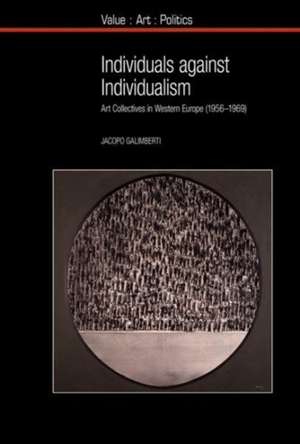Individuals against Individualism – Art Collectives in Western Europe (1956–1969)
Autor Jacopo Galimbertien Limba Engleză Paperback – 10 iul 2017
and geopolitical conflicts. Groups of artists and activists including Equipo 57, Equipo Cronica, Equipo Realidad, N, GRAV, Spur, Geflecht and Kommune I, have often been neglected in the English-speaking world. This happened partly because they were active in allegedly minor art centres such as
Valencia, Padua, Cordoba, West-Berlin and Munich. However, their works, debates and intellectual networks cast new light on both the art produced during the Cold War and the heightened interest in participatory and collaborative art practices that has characterised the art world of the 2000s and
2010s. Individuals against Individualism tells the stories of these artists and activists, and focuses on their attempts to depict and embody forms of egalitarianism opposing the Eastern bloc authoritarianism as much as the Free world's ethos. By setting their political use of collective authorship,
resistance to institutional co-optation and attack on the 'ideology of freedom, against the backdrop of the Cold War, the book largely speaks to the present.
Preț: 195.58 lei
Nou
Puncte Express: 293
Preț estimativ în valută:
37.43€ • 38.78$ • 31.24£
37.43€ • 38.78$ • 31.24£
Carte indisponibilă temporar
Doresc să fiu notificat când acest titlu va fi disponibil:
Se trimite...
Preluare comenzi: 021 569.72.76
Specificații
ISBN-13: 9781786940056
ISBN-10: 1786940051
Pagini: 352
Ilustrații: 145 Illustrations, color
Dimensiuni: 159 x 234 x 24 mm
Greutate: 0.9 kg
Editura: Liverpool University Press
ISBN-10: 1786940051
Pagini: 352
Ilustrații: 145 Illustrations, color
Dimensiuni: 159 x 234 x 24 mm
Greutate: 0.9 kg
Editura: Liverpool University Press
Notă biografică
Dr Jacopo Galimberti is a British Academy Postdoctoral Fellow in the School of Social Sciences of the University of Manchester.
Descriere
A fascinating book about a countercultural milieu that attempted to establish innovative ideas of collectivity and individuality through the formation of art groups in the 1950s and 1960s.
